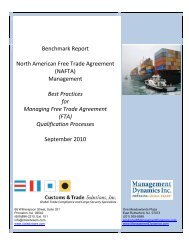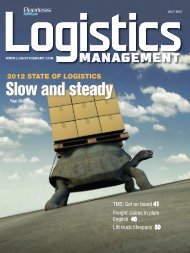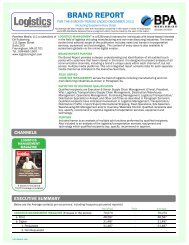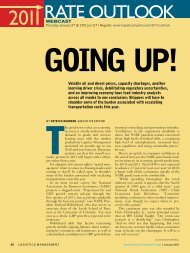that the TMS is “broken” and no longermaking sense.“In most cases, it’s not the TMS that’sbroken,” says Gonzalez. “The problem isthat you set it up two years ago, and thesame conditions no longer apply.” So,how does a company avoid this trap andensure that its TMS is optimized notonly today, but in the future?Squeezing the lemonOne of the easiest ways to determineif your new or existing TMS is runningon all cylinders is to simply pick up theproduct brochure to see exactly whatfeatures are included with your specificsetup. “Look at all of the piecesand parts, and see if you’re using all ofthem,” Aimi suggests. It sounds simpleenough, but how often do you really goback and review product guides afterthe systems are up, running, and managingthe basics functions as promised?If the brochure turns up interestingfeatures that you haven’t seen used inyour own operations, it’s time to talk toyour software vendor or systems integratorto find out why those featuresweren’t mobilized. A shipper that hiresa third-party provider to pay its freightbills, for example, would benefit financiallyby folding that function into itsTMS and using the system’s auto-payfeature. “That’s a pretty simple examplethat could lead to some significant savings,”says Aimi.Jim Davis, senior manager at theconsulting firm Capgemini, saysshippers should also ask themselveswhether their installed or hosted TMShas lived up to its initial vision. Is it performingthe functions that you thoughtit would? Has it automated tasks thatwere previously handled manually? Hasit helped reduce paper, phone calls, andfaxes? Is it saving the company money,time, and hassle?If the answer to any of those questionsis “no,” then Davis says it’s timeto revisit the scope of the project—that initial vision—and whether ornot you’re leveraging the toolset to itsfullest capacity. Davis states that thelatter is often to blame, and the problemis fairly easy to solve. “It’s reallyjust a matter of learning what yourTMS really has to offer, including newreleases and versions,” says Davis, “andadding the missing functionalities toyour own lineup.”Take dashboards, for example. Usedto retrieve and review metrics and analyticson the fly, TMS dashboards areoften left by the wayside when the<strong>October</strong> <strong>2011</strong> | WWW.LOGISTICSMGMT.COM <strong>Logistics</strong> <strong>Management</strong> 33
Optimizing TMSsoftware is rolled out. “Being able toquickly measure how well you’re doing,and what your TMS is doing for you,”says Aimi, “can be a valuable additionthat helps squeeze out a few more percentagepoints of savings.”Maintaining close ties with TMSvendors and/or developers (for homegrownsystems) can also go a long wayin helping a shipper get the most out ofits TMS. This holds true not only duringinstallation and implementation,but also in the months and years thatfollow. “Your vendor can clue you intoupcoming releases and new functionalitiesthat you might not otherwise hearabout,” says Davis.Aimi, whose firm expects the TMSmarket to experience double-digitgrowth in <strong>2011</strong> and a five-year compoundannual growth rate of 9.4 percent,also advises shippers to turn totheir vendors for help conducting TMSaudits that very often turn up “missinglinks” in the software’s value stream.“Software vendors usually have verygood examples of customers that areleveraging their products to their fullestpotential,” says Aimi. “In many cases, aquick meeting with the vendor can helpyou detect any gaps and help you prioritizeyour next optimization moves.”Outside consultants can also help.For example, Aimi points to Chainalyticsas one of several firms that specializesin supply chain performanceimprovement, and that offers a TMSaudit service. “They’ll come out andhelp you understand what you’re gettingfrom your TMS,” says Aimi, “and whatmore you could be gleaning from it.”Getting with the programIn today’s business environment it’seasy to get caught up in the day-to-daytasks and forget about the softwareengines that are driving productivityand savings. But you wouldn’t drive anautomobile for years without regular oilchanges, tire rotations, and brake fluidflushes—so why would you allow yourTMS investment to languish?“A TMS is not something that youset up once and forget about,” Gonzalezsays. “It’s a living, breathing solutionthat needs to be maintained regularlyin order to perform at optimal capacity.”Gonzalez advises shippers to takeTMS cost reduction opportunitiesTMS operation / capabilityTypical savingspotentialRate negotiations and compliance 4-15%Route and mode optimization 5-25%Carrier assignment optimization 4-8%Electronic communications w/ supply chain partners 2-6%Continuous moves and dedicated fleets 3-5%More efficient and automated operations 1-5%*Based on approximately 10 years of evidence from various customers of TMS systems, starting point proficiency/efficiency greatly determines the magnitude of savings from each of the areas.Source: Gartnerquarterly “snapshots” of their TMS tosee how they’re performing and whatadjustments need to be made. Alsoconsider the new software releases,upgrades, and/or patches that havebeen released recently, and determine“In many cases, corporationstry to find the low-hangingfruit of the tmS, in searchof functions that will providethe most value. They thenintegrate those functionsas ‘phase one’ of their tmSimplementation and nevergo beyond that point.”—Greg Aimi, Gartnerwhether they should be integrated intoyour existing setup.And don’t forget that freight ratesand other charges change regularly—a fact that should be reflected in theTMS. “To maintain data quality,” Gonzalezsuggests, “the content regardingcarriers, rates, and ship to and fromlocations should be validated at leastonce a year, if not more regularly.”Gonzalez, who recently attendeda TMS conference hosted by vendorMercuryGate, says shippers looking tooptimize their transportation operationsshould keep an eye on concepts like“embedded analytics” and “competitiveintelligence.” Put simply, Gonzalezsays these features will allow shippersto use real-time data points such as carrierlead times and create rules in theirTMS—which in turn will make automaticadjustments when the “triggerpoints” are reached.“There’s definitely a push to helpautomate more processes and keepTMS up to date and aligned with what’shappening in real-time,” says Gonzalez.For example: Let’s say preferred carrierY has been missing on-time deliverydeadlines or rejecting loads for noapparent reason for the last month.Using a pre-determined trigger point,the TMS will automatically generatean alert to the problem, thus allowingfor quick action—such as an e-mail orcall to the carrier, or a switch to anotherprovider—on the shipper’s part.These and other advanced featuresblend well with transportation managementsystems’ inherent mission ofautomating the transportation componentof the supply chain. Shippers thatrealize this—and that continue to workon optimizing their hosted and installedsoftware on a regular basis—will bewell positioned to squeeze maximumROI from their investments. “Just likea car,” says Gonzalez, “a TMS needs tobe regularly reviewed and tweaked inorder to run at its fullest potential.” MBridget McCrea is a Contributing Editorto <strong>Logistics</strong> <strong>Management</strong>34 <strong>Logistics</strong> <strong>Management</strong> WWW.LOGISTICSMGMT.COM | <strong>October</strong> <strong>2011</strong>
















